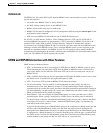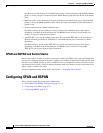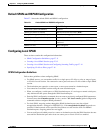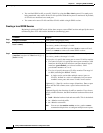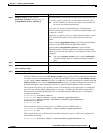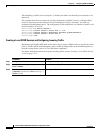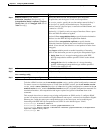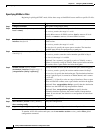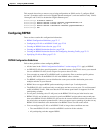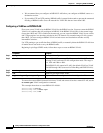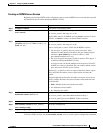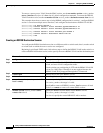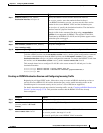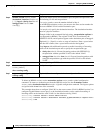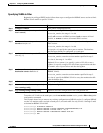
27-17
Catalyst 2960 and 2960-S Switch Software Configuration Guide
OL-8603-09
Chapter 27 Configuring SPAN and RSPAN
Configuring SPAN and RSPAN
This example shows how to remove any existing configuration on SPAN session 2, configure SPAN
session 2 to monitor traffic received on Gigabit Ethernet trunk port 2, and send traffic for only VLANs
1 through 5 and VLAN 9 to destination Gigabit Ethernet port 1.
Switch(config)# no monitor session 2
Switch(config)# monitor session 2 source interface gigabitethernet0/2 rx
Switch(config)# monitor session 2 filter vlan 1 - 5, 9
Switch(config)# monitor session 2 destination interface gigabitethernet0/1
Switch(config)# end
Configuring RSPAN
These sections contain this configuration information:
• RSPAN Configuration Guidelines, page 27-17
• Configuring a VLAN as an RSPAN VLAN, page 27-18
• Creating an RSPAN Source Session, page 27-19
• Creating an RSPAN Destination Session, page 27-20
• Creating an RSPAN Destination Session and Configuring Incoming Traffic, page 27-21
• Specifying VLANs to Filter, page 27-23
RSPAN Configuration Guidelines
Follow these guidelines when configuring RSPAN:
• All the items in the “SPAN Configuration Guidelines” section on page 27-11 apply to RSPAN.
• As RSPAN VLANs have special properties, you should reserve a few VLANs across your network
for use as RSPAN VLANs; do not assign access ports to these VLANs.
• You can apply an output ACL to RSPAN traffic to selectively filter or monitor specific packets.
Specify these ACLs on the RSPAN VLAN in the RSPAN source switches.
• For RSPAN configuration, you can distribute the source ports and the destination ports across
multiple switches in your network.
• RSPAN does not support BPDU packet monitoring or other Layer 2 switch protocols.
• The RSPAN VLAN is configured only on trunk ports and not on access ports. To avoid unwanted
traffic in RSPAN VLANs, make sure that the VLAN remote-span feature is supported in all the
participating switches.
• Access ports (including voice VLAN ports) on the RSPAN VLAN are put in the inactive state.
• RSPAN VLANs are included as sources for port-based RSPAN sessions when source trunk ports
have active RSPAN VLANs. RSPAN VLANs can also be sources in SPAN sessions. However, since
the switch does not monitor spanned traffic, it does not support egress spanning of packets on any
RSPAN VLAN identified as the destination of an RSPAN source session on the switch.
• You can configure any VLAN as an RSPAN VLAN as long as these conditions are met:
–
The same RSPAN VLAN is used for an RSPAN session in all the switches.
–
All participating switches support RSPAN.



